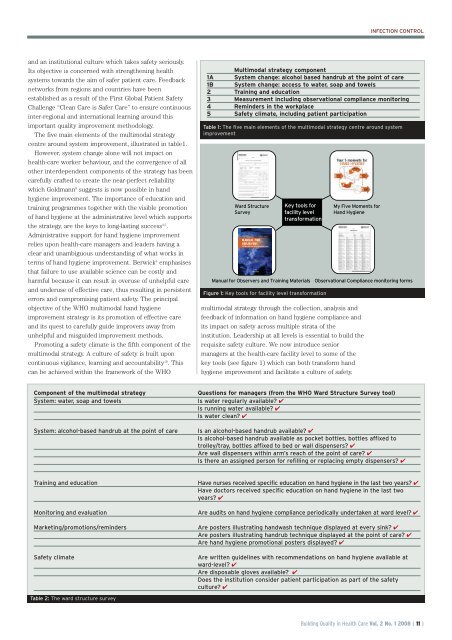The WHO multimodal hand hygiene improvement strategy
The WHO multimodal hand hygiene improvement strategy
The WHO multimodal hand hygiene improvement strategy
You also want an ePaper? Increase the reach of your titles
YUMPU automatically turns print PDFs into web optimized ePapers that Google loves.
INFECTION CONTROL<br />
and an institutional culture which takes safety seriously.<br />
Its objective is concerned with strengthening health<br />
systems towards the aim of safer patient care. Feedback<br />
networks from regions and countries have been<br />
established as a result of the First Global Patient Safety<br />
Challenge “Clean Care is Safer Care” to ensure continuous<br />
inter-regional and international learning around this<br />
important quality <strong>improvement</strong> methodology.<br />
<strong>The</strong> five main elements of the <strong>multimodal</strong> <strong>strategy</strong><br />
centre around system <strong>improvement</strong>, illustrated in table1.<br />
However, system change alone will not impact on<br />
health-care worker behaviour, and the convergence of all<br />
other interdependent components of the <strong>strategy</strong> has been<br />
carefully crafted to create the near-perfect reliability<br />
which Goldmann 8 suggests is now possible in <strong>hand</strong><br />
<strong>hygiene</strong> <strong>improvement</strong>. <strong>The</strong> importance of education and<br />
training programmes together with the visible promotion<br />
of <strong>hand</strong> <strong>hygiene</strong> at the administrative level which supports<br />
the <strong>strategy</strong>, are the keys to long-lasting success 4,5 .<br />
Administrative support for <strong>hand</strong> <strong>hygiene</strong> <strong>improvement</strong><br />
relies upon health-care managers and leaders having a<br />
clear and unambiguous understanding of what works in<br />
terms of <strong>hand</strong> <strong>hygiene</strong> <strong>improvement</strong>. Berwick 9 emphasises<br />
that failure to use available science can be costly and<br />
harmful because it can result in overuse of unhelpful care<br />
and underuse of effective care, thus resulting in persistent<br />
errors and compromising patient safety. <strong>The</strong> principal<br />
objective of the <strong>WHO</strong> <strong>multimodal</strong> <strong>hand</strong> <strong>hygiene</strong><br />
<strong>improvement</strong> <strong>strategy</strong> is its promotion of effective care<br />
and its quest to carefully guide improvers away from<br />
unhelpful and misguided <strong>improvement</strong> methods.<br />
Promoting a safety climate is the fifth component of the<br />
<strong>multimodal</strong> <strong>strategy</strong>. A culture of safety is built upon<br />
continuous vigilance, learning and accountability 10 . This<br />
can be achieved within the framework of the <strong>WHO</strong><br />
Multimodal <strong>strategy</strong> component<br />
1A System change: alcohol based <strong>hand</strong>rub at the point of care<br />
1B System change: access to water, soap and towels<br />
2 Training and education<br />
3 Measurement including observational compliance monitoring<br />
4 Reminders in the workplace<br />
5 Safety climate, including patient participation<br />
Table 1: <strong>The</strong> five main elements of the <strong>multimodal</strong> <strong>strategy</strong> centre around system<br />
<strong>improvement</strong><br />
Ward Structure<br />
Survey<br />
Key tools for<br />
facility level<br />
transformation<br />
Manual for Observers and Training Materials<br />
Figure 1: Key tools for facility level transformation<br />
My Five Moments for<br />
Hand Hygiene<br />
Observational Compliance monitoring forms<br />
<strong>multimodal</strong> <strong>strategy</strong> through the collection, analysis and<br />
feedback of information on <strong>hand</strong> <strong>hygiene</strong> compliance and<br />
its impact on safety across multiple strata of the<br />
institution. Leadership at all levels is essential to build the<br />
requisite safety culture. We now introduce senior<br />
managers at the health-care facility level to some of the<br />
key tools (see figure 1) which can both transform <strong>hand</strong><br />
<strong>hygiene</strong> <strong>improvement</strong> and facilitate a culture of safety.<br />
Component of the <strong>multimodal</strong> <strong>strategy</strong><br />
System: water, soap and towels<br />
System: alcohol-based <strong>hand</strong>rub at the point of care<br />
Questions for managers (from the <strong>WHO</strong> Ward Structure Survey tool)<br />
Is water regularly available? ✔<br />
Is running water available? ✔<br />
Is water clean? ✔<br />
Is an alcohol-based <strong>hand</strong>rub available? ✔<br />
Is alcohol-based <strong>hand</strong>rub available as pocket bottles, bottles affixed to<br />
trolley/tray, bottles affixed to bed or wall dispensers? ✔<br />
Are wall dispensers within arm’s reach of the point of care? ✔<br />
Is there an assigned person for refilling or replacing empty dispensers? ✔<br />
Training and education<br />
Monitoring and evaluation<br />
Marketing/promotions/reminders<br />
Safety climate<br />
Have nurses received specific education on <strong>hand</strong> <strong>hygiene</strong> in the last two years? ✔<br />
Have doctors received specific education on <strong>hand</strong> <strong>hygiene</strong> in the last two<br />
years? ✔<br />
Are audits on <strong>hand</strong> <strong>hygiene</strong> compliance periodically undertaken at ward level? ✔<br />
Are posters illustrating <strong>hand</strong>wash technique displayed at every sink? ✔<br />
Are posters illustrating <strong>hand</strong>rub technique displayed at the point of care? ✔<br />
Are <strong>hand</strong> <strong>hygiene</strong> promotional posters displayed? ✔<br />
Are written guidelines with recommendations on <strong>hand</strong> <strong>hygiene</strong> available at<br />
ward-level? ✔<br />
Are disposable gloves available? ✔<br />
Does the institution consider patient participation as part of the safety<br />
culture? ✔<br />
Table 2: <strong>The</strong> ward structure survey<br />
Building Quality in Health Care Vol. 2 No. 1 2008 ( 11 )

















